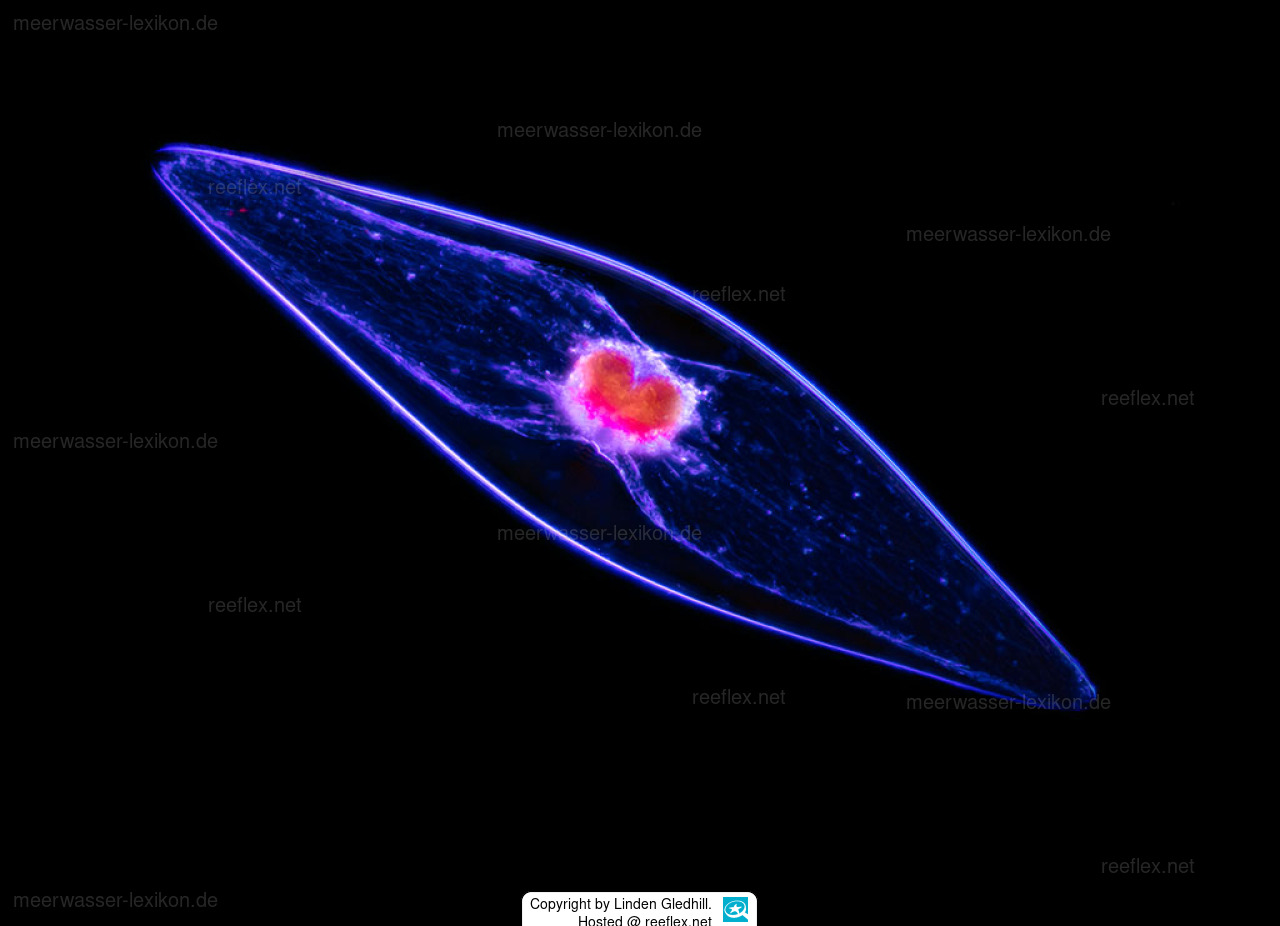Info
As a child, I saw a firefly (Lampyridae) for the first time in the Harz Mountains late in the evening, flying through the night with its yellow-greenish light, clearly visible, a great experience.
Even more overwhelming are personal sightings of green-bluish bioluminescence, which brightly illuminate some beach areas.
Unfortunately, we cannot currently show a photo of such a small wonder, but can only refer you to a link that shows such natural phenomena:
https://www.watson.de/nachhaltigkeit/klima-umwelt/687781998-biolumineszenz-an-diesen-orten-kannst-du-das-meer-leuchten-sehen
Responsible for such marine lights are dinoflagellates such as Pyrocystis fusiformis, a self-motile algae that reaches a size of one μm, which corresponds to 0.00100 mm.
We would especially like to thank Linden Gledhill, USA, who was able to take two beautiful fluorescence microscope photos of Pyrocystis fusiformis.
Below is his information:
"My first attempt at fluorescence microscopy. The subject is a marine bioluminescent dinoflagellate, Pyrocystis fusiformis (biopop.com/products/dino-pet). This image is a 6-image focus stack (10x objective) with dark field excitation at 365 nm and a viewing filter at 420 nm. The chloroplasts, which are brown in full spectrum light, glow bright red. I have to find out how I can stimulate the bioluminescence under a cover glass. This image is a 6-image focus stack (10x objective) with dark field excitation at 365 nm and a viewing filter at 420 nm. The chloroplasts, which are brown in full spectrum light, glow bright red"
Pyrocystis fusiformis uses a pigment called luciferin and an enzyme called luciferase.
When the enzyme luciferase oxidizes the pigment, the energy of the reaction is released in a tiny flash of light.
When Pyrocystis fusiformis glows in nature, it glows so brightly that the entire surf is dazzling with an eerie blue-green light.
However, Pyrocystis fusiformis only glows when it is disturbed, be it breaking waves, the movements of a nocturnal swimmer or the attack of a predator.
It is even thought that the reason dinoflagellates have evolved the ability to glow is because they don't want to be eaten (unlike fireflies, which flash in intricate patterns to attract a mate).
In the dark ocean, not being seen is an advantage.
If a zooplankton eater takes a glowing dinosaur into its mouth, it will probably spit it out immediately rather than risk glowing itself.
Otherwise, it could be seen by a larger (more obscure) predator and become fish food.
This glowing defense mechanism is particularly important for Pyrocystis fusiformis as they have no flagella and are not mobile, i.e. they cannot swim away. but only
move up and down in the water column by adjusting their buoyancy.
Etymology: The genus name "Pyrocystis" is derived from the Latin "pyro" for (fire) and "cystis" for hollow sac or cavity,
Synonyms
Dissodinium fusiforme (Wyville-Thomson ex Murray) Matzenauer - unaccepted (synonym)
Dissodinium fusiformis (J.Murray) Matzenauer, 1933 - unaccepted
Murracystis fusiformis (C.W.Thomson) Haeckel, 1890 - unaccepted (synonym)
Even more overwhelming are personal sightings of green-bluish bioluminescence, which brightly illuminate some beach areas.
Unfortunately, we cannot currently show a photo of such a small wonder, but can only refer you to a link that shows such natural phenomena:
https://www.watson.de/nachhaltigkeit/klima-umwelt/687781998-biolumineszenz-an-diesen-orten-kannst-du-das-meer-leuchten-sehen
Responsible for such marine lights are dinoflagellates such as Pyrocystis fusiformis, a self-motile algae that reaches a size of one μm, which corresponds to 0.00100 mm.
We would especially like to thank Linden Gledhill, USA, who was able to take two beautiful fluorescence microscope photos of Pyrocystis fusiformis.
Below is his information:
"My first attempt at fluorescence microscopy. The subject is a marine bioluminescent dinoflagellate, Pyrocystis fusiformis (biopop.com/products/dino-pet). This image is a 6-image focus stack (10x objective) with dark field excitation at 365 nm and a viewing filter at 420 nm. The chloroplasts, which are brown in full spectrum light, glow bright red. I have to find out how I can stimulate the bioluminescence under a cover glass. This image is a 6-image focus stack (10x objective) with dark field excitation at 365 nm and a viewing filter at 420 nm. The chloroplasts, which are brown in full spectrum light, glow bright red"
Pyrocystis fusiformis uses a pigment called luciferin and an enzyme called luciferase.
When the enzyme luciferase oxidizes the pigment, the energy of the reaction is released in a tiny flash of light.
When Pyrocystis fusiformis glows in nature, it glows so brightly that the entire surf is dazzling with an eerie blue-green light.
However, Pyrocystis fusiformis only glows when it is disturbed, be it breaking waves, the movements of a nocturnal swimmer or the attack of a predator.
It is even thought that the reason dinoflagellates have evolved the ability to glow is because they don't want to be eaten (unlike fireflies, which flash in intricate patterns to attract a mate).
In the dark ocean, not being seen is an advantage.
If a zooplankton eater takes a glowing dinosaur into its mouth, it will probably spit it out immediately rather than risk glowing itself.
Otherwise, it could be seen by a larger (more obscure) predator and become fish food.
This glowing defense mechanism is particularly important for Pyrocystis fusiformis as they have no flagella and are not mobile, i.e. they cannot swim away. but only
move up and down in the water column by adjusting their buoyancy.
Etymology: The genus name "Pyrocystis" is derived from the Latin "pyro" for (fire) and "cystis" for hollow sac or cavity,
Synonyms
Dissodinium fusiforme (Wyville-Thomson ex Murray) Matzenauer - unaccepted (synonym)
Dissodinium fusiformis (J.Murray) Matzenauer, 1933 - unaccepted
Murracystis fusiformis (C.W.Thomson) Haeckel, 1890 - unaccepted (synonym)







 Linden Gledhill, USA
Linden Gledhill, USA


